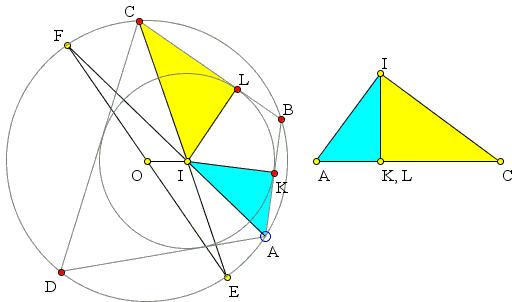Fuss' Theorem
The applet below illustrates Poncelet's porism for quadrilaterals. It is based on a formula by Nicolaus Fuss (1755-1826), a student and friend of L. Euler. Fuss also found the corresponding formulas for the bicentric pentagon, hexagon, heptagon, and octagon [Dörrie, p. 192].
| What if applet does not run? |
|Activities| |Contact| |Front page| |Contents| |Geometry|
Copyright © 1996-2007 Alexander BogomolnyThe circumradius (R), the inradius (r) and the distance between the circumcenter and the incenter (d) of a bicentric quadrilateral stand in an elegant relationship
| 1/(R - d)2 + 1/(R + d)2 = 1/r2, |
It looks very much the same as Euler's formula for triangles, except for the exponent of 2.
Here's a very short proof of this fact by J. C. Salazar:

|
Let the two circles be O(R) and I(r), K and L be the points where circle I(r) touches AB and BC.
Since quadrilateral ABCD is cyclic the angles at A and C are supplementary making angles BAI and ICB complimentary:
| ∠BAI + ∠ICB = 90°. |
By construction, IK = IL = r. Two triangles AIK and CIL combined form a right triangle with legs AI and CI and the hypotenuse
| (1) | r·(AK + CL) = AI · CI. |
Also, the Pythagorean theorem applied to that triangle gives
| (2) | (AK + CL)² = AI² + CI². |
| r²·(AI² + CI²) = AI² · CI², |
or,
| (3) | 1/r² = 1/AI² + 1/CI². |
Let AI and CI produced intersect O(R) in F and E. Then EF is a diameter of C(R) because
|
We are then in a position to apply the formula for the length of a median (IO) in a triangle (EFI):
| (4) |
|
Considering the diameter of O(R) through I, the intersecting chords theorem gives
| (5) | AI · FI = CI · EI = R² - d² |
It follows (from (4) and (5)) that
| (6) |
|
|
References
- N. Altshiller-Court, College Geometry, Dover, 1980
- J. Casey, A Sequel to Euclid, Scholarly Publishing Office, University of Michigan Library (December 20, 2005), reprint of the 1888 edition, pp. 107-110
- J. L. Coolidge, A Treatise On the Circle and the Sphere, AMS - Chelsea Publishing, 1971, p. 45
- H. Dörrie, 100 Great Problems Of Elementary Mathematics, Dover Publications, NY,1965
- F. G.-M., Exercices de Géométrie, Éditions Jacques Gabay, sixiéme édition, 1991, pp. 837-839
- J. C. Salazar, Fuss' Theorem, The Mathematical Gazette, v 90, n 518 (July 2006), pp. 306-307.
Poncelet Porism
- Poncelet's Porism
- Extouch Triangle in Poncelet Porism
- Fuss' Theorem
- Intouch Triangle in Poncelet Porism
- Euler's Formula and Poncelet Porism
- Poncelet Porism in Ellipses
|Contact| |Front page| |Contents| |Geometry| |Eye opener|
Copyright © 1996-2018 Alexander Bogomolny
73573095
